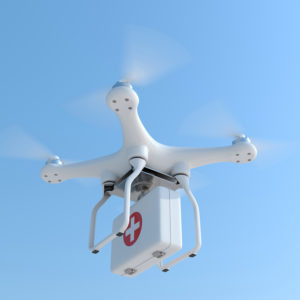The future is evident in the skies over Rwanda and Ghana. Both boast nationwide systems of medical drones — unmanned aerial vehicles carrying blood products and other medical supplies to locations across those countries.
Zipline, a California-based company that operates both countries’ drones, says it has conducted more than 26,000 medical missions. Rwanda is the size of Maryland, and according to Zipline, drones carry nearly two-thirds of blood-product deliveries outside of the capital city.
Establishing a similar system in the United States is perhaps less critical and more difficult, yet such efforts are underway. It’s less critical because our transportation routes are better than in most developing countries. It’s more difficult because our skies are far more crowded with airplanes, helicopters and other vehicles.
Nevertheless, drones offer lifesaving possibilities here as well. In 2019, a drone carried a kidney destined for transplant across Baltimore. In North Carolina, the WakeMed hospital system is transporting blood products by drone. Recently, the Federal Aviation Administration granted UPS permission to establish our country’s first unmanned airline, with an eye toward medical deliveries.
In a new Mercatus Center research paper, Darcy Bryan (an obstetrician), John Coglianese (a military drone expert), and I (an economist and policy researcher) explore the virtues of medical drones and the difficulties of deploying them over America’s skies.
Blood products are a natural payload for drones. With a mother hemorrhaging during childbirth, for example, a few minutes can mean the difference between life and death for mother and child. Sometimes, required blood supplies may be too far away by land vehicle or even helicopter to make a difference. Zipline has documented such lifesaving experiences in its African operations.
In the United States, drones could serve multiple purposes. We have vast rural areas where conventional ground or air transportation is slow or costly. Urban areas suffer from traffic jams. Sometimes ice storms, high winds, or natural disasters make it difficult or impossible for humans to transport lifesaving cargos— including not only blood products but also surgical supplies, drugs and vaccines, transplantable organs, defibrillators, telemedicine kits, and disaster-era food and medical supplies. Several entities are experimenting with drones to carry medical patients themselves. These unmanned air ambulances — effectively small, remote-controlled helicopters — could carry medical personnel and patients without the need for onboard pilots.
The potential is great, but it’s important to temper optimism with pragmatism. Large-scale medical drone use in America or in other developed countries will require simultaneous advances in technology and in regulation. A wayward drone has the capacity to down an airliner, potentially ending the public’s willingness to tolerate this new vehicle in our skies. Today’s small, battery-powered drones have limited range and weight-bearing capacity. Most challenging is making the vehicles safe enough to allow beyond the visual line of sight missions. Currently, U.S. drones are generally not allowed to fly beyond the remote pilot’s eyes; exceptions are only allowable on a case-by-case basis.
Several technological advances will be necessary to make this dream a reality. Drones will need better, more reliable air-to-ground communications than airplanes currently enjoy, since there will be no onboard pilot to handle situations when communications break down. This will likely require increased bandwidth and greater access to satellite channels.
Drones will need enormously reliable sense-and-avoid capabilities — software and artificial intelligence to assure that the vehicles don’t strike airplanes, buildings, electrical wires or other obstacles — including individual humans. They’ll have to be highly resistant to hackers, terrorists and other nefarious characters. Long-distance flights will likely require miniaturized internal combustion engines that do not currently exist. And the industry will have to construct an extensive ground-based infrastructure.
Regulators will face a tough balancing act — developing the capacity to monitor the safety of this technology without snuffing out the incentives for innovators to undertake the expensive development costs described above. The architecture of U.S. airspace was devised in the 1950s, and it will be no small feat to integrate a potentially vast number of small, nimble, unmanned vehicles into that airspace. Plus, there are privacy issues, with every drone a potential spy.
Drones can save American lives and perhaps reduce costs. But deploying the technology will require a well-coordinated effort by lawmakers, regulators, manufacturers and medical facilities.


